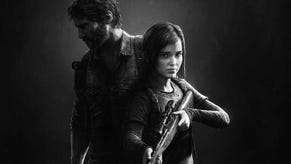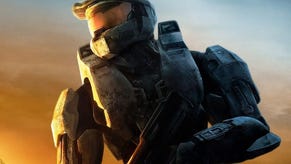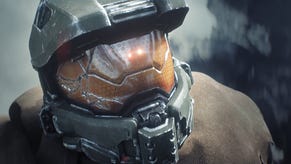E3 2012: Hail to the King: the Chief returns for Halo 4
He’s saved mankind, championed the Xbox and entertained millions, but Stace Harman has never been a fan of this little green man. Could that be about to change with Halo 4?
It’s true, I’ve never been a fan of Master Chief. His name (or, more accurately, the rank that has become his name) has always felt like it was decided upon by committee as a deliberately macho moniker that lacked any subtly and could have been made up of any two equally strong sounding words: Prime General, Imperial Alpha, Ultra Vox; the sound of it has always jarred.
His lack of both face and voice have been equally as troubling to me, but not because I can’t relate to the strong, silent types; I’ve spent a lot of time with the lead characters of Bioshock, Half-Life and Zelda and rarely felt disconnected from them.
I think it’s because I’m told that Master Chief is a big deal and all I see is an ignorant man in a silly costume with a nonsensical name – although, for various reasons I of all people should probably be able to relate to that.
A while back, Microsoft said that with Halo Reach and ODST the company lost its way, and that, paraphrasing somewhat, it was to do with not playing as Master Chief. I didn’t get that at all.
I mean, in Bioshock and Half-Life the character you play does not make or break the game; perhaps more so with Zelda games, where Link’s persistent presence in each title is more integral to the experience, but then Zelda games are predominantly third-person affairs and a protagonist’s role in a third-person game is very different to that of a first-person title.
Not surprisingly, franchise development director at 343 Industries, Frank O’Connor – who has been with the series since Halo 2 – doesn’t think that Master Chief’s absence was to the detriment of either Reach or ODST, though he concedes that his return in Halo 4 feels very natural.
“Both [Reach and ODST] were successful, so I wouldn’t say that they were hurt [by not featuring Master Chief] necessarily, but it was definitely a thing that we thought about,” admits O’Connor.
“Basically, people would just rather watch a story about Master Chief, in the same way that you’d rather watch a story of Lord of the Rings with Bilbo Baggins and Frodo and those guys. People just miss them if they’re not there.”
To me, this says something about the strength of the world and the narrative that surrounds the character, rather than the character themselves. Reach and ODST were consistent, well-made titles that enhanced the Halo brand, but both were very deliberately kept apart from the canonical storyline.
“[Chief] has a little bit of a personality. He’s stoic and heroic but, sure, those are hardly unusual characteristics in a video game protagonist, right? But because he’s faceless and because he’s quiet, he’s reactive and so he’s defined by the things around him."
They were used to further explore the deep lore of the universe to great effect and both featured stellar production values, but all the while they felt like side dishes to Master Chief’s main meal, prompting that nagging feeling that without the Chief, Halo just isn’t Halo.
Can that be true? Can you miss the presence of something or someone, even if it lacks an explicit personality?
“He has a little bit of a personality,” argues O’Connor. “He’s stoic and heroic but, sure, those are hardly unusual characteristics in a video game protagonist, right? But because he’s faceless and because he’s quiet, he’s reactive and so he’s defined by the things around him.
“Chief is a great hero, but he’s also a great vehicle to invest yourself in and to discover your own sense of adventure. In some ways, he’s become the standard-bearer for that very specific feeling that you get in a game of this kind.”
Master Chief as an icon makes more sense to me than Master Chief as an engaging character and perhaps that’s the very point that O’Connor and 343 Industries, as well as Bungie before them, have been making all along: that Master Chief is collection of ideals and an emblem for epic adventure.
Whether I can see that or not is irrelevant because Master Chief is, to a large degree, different things to different people. In the same way that I’m sure some of my favourite video game characters with defined personalities – Geralt, Vincent, Lara – are not to everyone’s taste, Chief isn’t to mine, but that doesn’t mean that he’s not important.
“With him, it just makes people...you’re not constantly reminding the player that they’re not a hero, or that they’re not the Master Chief,” says O’Connor, trying to verbalise Chief’s precise appeal.
“We have kids from all walks of life, background, creed, ability and gender who all feel like they are the Master Chief and who are never wrenched out of that sense of immersion because of anything that he does.
“With third person games, you have a really well-defined character like Nathan Drake, but it’s a story about Nathan Drake and that’s what people are invested in. The Master Chief is a little bit different; people don’t even call him by his name, they call him by his rank because that’s the rank that you take on when you’re in his shoes.”
They’re big shoes and whether they could perhaps be filled by anyone else is soon to be rendered a moot point because the Master Chief is returning for Halo 4.
He’s returning to empower mere mortals, he’s returning and bringing with him the start of a new tale of intergalactic heroism and he’s returning to continue the seldom-mentioned love affair that clearly bubbles beneath the surface of his relationship with Cortana.
He is returning and I, Stacey Leigh Harman, find myself caring a little more about him than I once did, even if I still think he has a very silly name.
Halo 4 launches on Xbox 360 on November 6 worldwide.










